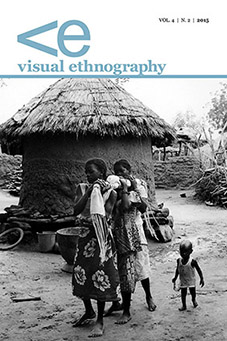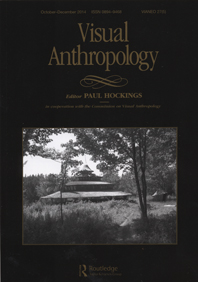VISUAL ETHNOGRAPHY vol. 4, n. 2
is available in printed and online version
SUMMARY
ARTICLES
Bill Buse
What Becomes A Bride The Most: The Yemenite Jewish Henna
ABSTRACT
The Yemenite Jewish henna bride is widely admired and envied in Israel. Her iconic image is reified and exhibited in shops, on billboards, and in museums for political and economic purposes. Simultaneously, the local folk culture reveres the Yemenite henna dressing as a living custom reminiscent of their life in Yemen. A pictorial narrative tracing the fate of the henna ceremony in Israel depicts the efforts of one local dresser to construct a sublime bride, thus placing her beyond interpretation and exploitation. Her success is realized in a shocking, surrealistic vision of the Marvelous. This experiment in ethnographic form and content borrows heavily from the languages of surrealism and psychoanalysis as the author, following the dresser, attempts to construct a textual artifact that is representative of her work.
Yohai Hakak
Filmed ‘Not During the Sabath’: The Haredi Society through the Camera’s lens
ABSTRACT
The Haredi (Jewish Ultra Orthodox) minority in Israel has an increased visibility in Israeli media in recent years. Many of its representations are negative and stereotypical. This article is an analysis of a documentary series about this minority group that the author co-directed also in an attempt to challenge these stereotypes. The article analyses the process of production of the series and the many decisions that had to be taken during it. It explores the difficulties in challenging the key stereotypes, especially in the context of Israeli commercial television.
Jorge Grau Rebollo
Confronting success: film narratives of social contestation
ABSTRACT
The notion of success appears frequently as the epitome of personal fulfilment and films have been often selected as the preferred vehicle for materializing narratives of prosperity, triumph and good life. Nevertheless, films may also be used as devices for the exposure of uncertainty, disenchantment or broken hopes. In this article, I propose to use some particular examples of Spanish movies as empirical repertoire for considering the relevance of fiction films in confronting uncertainty and both exposing social discontent and promoting active contestation, thus weaving a sense of continuum between different generations and contexts.
Stefania Sebastianis
Artisti e antropologi: il compadrazgo antropologico e la creazione dell’arte indigena peruviana
ABSTRACT
The present-day representation of Andean indigenous culture, expressed through Peruvian folk art, is the product of the historical collaboration between anthropologists and artists. This long-lasting relationship, marked by the overlapping of the mutual identities of the subjects involved, is based on the asymmetrical relationship of the compadrazgo. By retracing the history that has linked indigenous artists to anthropological research since the indigenist period, one cannot help but notice how research plays a crucial role not only in creating the value and the authenticity of the objects within a market, but also in their own conception.
PHOTO-ESSAY
Maria Luisa Ciminelli
Le kolonkalanin : Une démonstration du pilon magique au Bélédougou (Mali)
ABSTRACT
This photo-essay documents the functioning of the kolonkalanin, or “pilon magique” (magical pestle), during a demonstration of its power. One of the most important and fearsome fetishes of the Bamana people of Mali, the kolonkalanin is also featured in the film Yeelen by Souleymane Cissé (1987). The analogic photographs of this reportage have been taken in a village of Bélédougu, where I came back in 1999 to meet once again the soma (great initiate), Keifa Diarra. Keifa Diarra himself wanted me to assist at the demonstration, to take pictures of it, and to record his words.
REPORTS
Anson Mak
Artists’ Studios and Their Practices In Kwun Tong Industrial Buildings: A Hyper-video ethnographic study
ABSTRACT
This is a research-creative project, in which the topic of research, research methods and ways of presenting research findings are essential concern. This project shows ways artists/designers live and work in the vibrant Kwun Tong area. Since the late 1980’s, factories have begun to move to Mainland China. Then, various types of small businesses and creative industries and artists have been moving in. Gradually, they turn the town into a creative community/cluster. However, since 2010, the Hong Kong Government introduced the Policy of Revitalization of Factory Buildings. This problematic policy has brought terrible destruction to the area and caused unaffordable property prices. The web site features creative folks in twenty-five studios working on various media. Ethnographic video and academic findings are presented in a hyper-video web-site that works together with edited transcription.
REVIEWS
Felicia Hughes-Freeland
Review of “Kalanda: Knowledge of the Bush”, a film by Lorenzo Ferrarini




